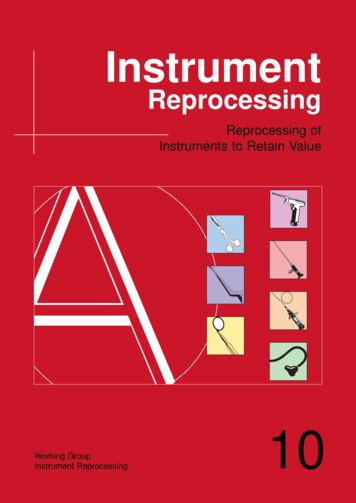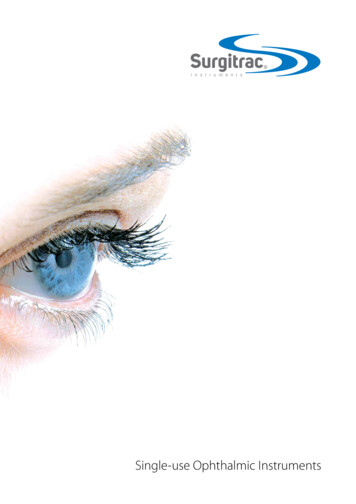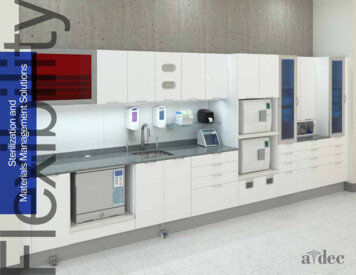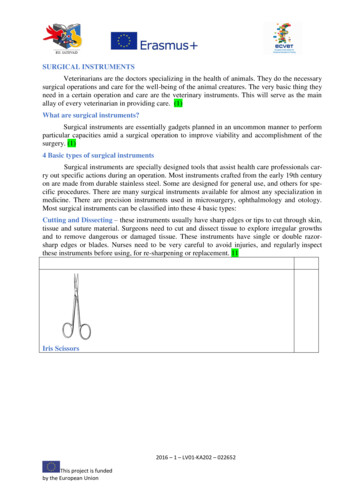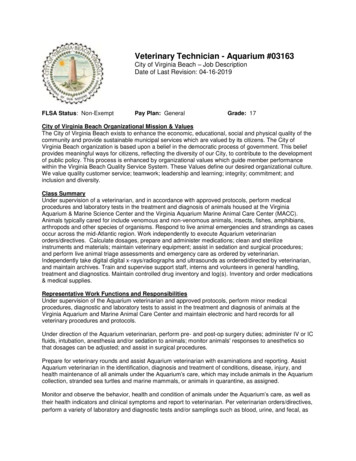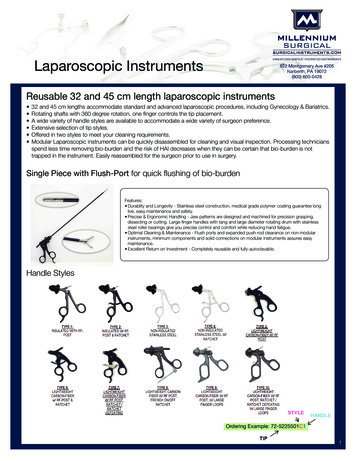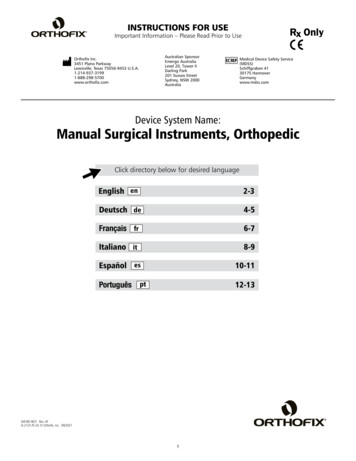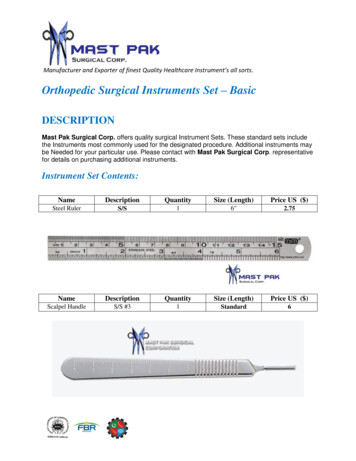
Transcription
How to sterilize instruments and jewellery andcomply with the Infection Control Guidelines forPersonal Appearance Services 2012.To prevent the spread of disease, reusable instruments used in skinpenetration procedures must be thoroughly cleaned and then sterilized beforeuse.This fact sheet has been developed to assist practitioners to understand the requirements for sterilizingtheir reusable instruments and jewellery. This fact sheet should be read in conjunction with Appendix 1 of“What business needs to know” which provides a summary of Australian/New Zealand Standard 4815:2006and the Infection Control Guidelines for Personal Appearance Services 2012.Standards referred to in this fact sheet AS/NZ 4815: 2006 - Office based health care facilities – Reprocessing of reusable medical andsurgical instruments and equipment, and maintenance of the associated environment AS 2182: 1998 - Sterilizers - Steam - Benchtop AS/NZ 4187: 2014 - Reprocessing of reusable medical devices in health service organisationsSingle-use itemsInstruments/items that are manufactured as single-use are to be used once and discarded. Instruments thatpenetrate the skin and cannot be adequately cleaned and/or sterilized must not be re-used, they must be'single use'. Single-use items must be immediately disposed into an approved sharps container followinguse on a client.Sterilizing jewelleryAll jewellery used in providing a higher risk personal appearance service must be pre-sterilized.Jewellery displayed for sale (unless pre-sterilized in sealed packaging) must be resterilized prior to beingused in a higher risk procedure.Stocks of pre-sterilized jewellery should be rotated to ensure the sterilization dates are current.How do you sterilize?Sterilization must be carried out in accordance with AS/NZS 4815:2006.This Australian Standard outlines the critical steps involved in sterilization.
What do you need to do before you sterilize your instruments?Ensure the premises are designed properly.The cleaning and sterilization of instruments and jewellery should be conducted away from clients,preferably in a separate room.Workflow for instrument processing should be from dirty - to clean - to sterile – to storage.A manual should be available for staff on 'cleaning procedures'.Instrument cleaning:Instruments should be cleaned as soon as practicable after use.It is important to clean instruments prior to sterilization because dirty instruments cannot be properlysterilized.Appropriate Personal Protective Equipment (PPE) should be worn to protect against aerosol exposure fromwashing soiled equipment. That includes gloves, eye protection, fluid repellent masks and fluid resistantaprons or gowns.Instruments and jewellery must be thoroughly cleaned (i.e. via scrubbing, using an instrument washer,and/or ultra-sonic cleaner) before processing through a bench-top steriliser.The cleaning process should minimise the generation of aerosols.Instruments that are difficult to clean and sterilize should only be used once and then disposed ofappropriately (single-use only).Manufacturer's instructions must be followed for the use of cleaning agents and instruments.NOTE: Ultra-sonic cleaners are an adjunct to manual or mechanical cleaning an instrument. They do notclean and/or disinfect instruments.Manual cleaning requires the use of two sinks or bowls, which are kept clean and dedicated solely for thatpurpose, one with detergent solution for the actual cleaning activity and one with water for rinsing itemsafter they have been cleaned. A suitable stiff-bristled brush is a useful implement for manual cleaning.Brushing equipment under the water surface minimises potentially hazardous aerosols.Mechanical cleaning (usually also with a thermal disinfection stage) is able to be provided in a machinesimilar to a domestic dish washer machine. This however does not necessarily disinfect the instruments.Use the ultra-sonic cleaner in accordance with the manufacturer's instructions.AS/NZ 4815:2006 provides some instruction on the use of the ultra-sonic cleaner.AS/NZ 4187:2014 provides some useful recommendations concerning the quality of water used in cleaningand the choice of cleaning chemicals.Instruments must be properly dried - residue moisture may impede the sterilization process, and candamage instruments.Packaging prior to sterilization:Instruments must be packaged and labelled prior to placing in a sterilizer. This will maintain sterility andpermit aseptic removal of the contents of the pack at the time of use. An exception to this requirement is ifitems are used immediately after processing through a bench-top sterilizer.Packaged items should be positioned in an upright position or in accordance with the manufacturer'sinstructions.How to sterilize instruments and jewellery and comply with the Infection Control Guidelines for PersonalAppearance Services 2012.-2-
Most packaging contains a class 1 indicator that shows that the load has been reprocessed. This indicatordoes not show that the load has been sterilized. The use of indicators should be considered at the time ofpackaging the instruments.Further information of packaging and wrapping of items prior to sterilization is available in AS/NZS4815:2006. Issues discussed include pack size, labelling, specific packaging and wrapping requirementsand methods of wrapping.Operation of SterilizersThe staff using a sterilizer at a facility must be appropriately and adequately trained in the operation of thatsterilizer.The essential requirement in both steam and dry heat sterilization is to reliably achieve a minimum time at anominated temperature in the sterilizer chamber and throughout all parts of the load being sterilized. Forsteam sterilization in the health and beauty industries this requirement is 3 minutes at 134ºC after air hasbeen reliably removed from the chamber and the load items. In dry heat sterilization 2 hours at 160ºC isnecessary.In each case, the operator or their agent must have determined the extra time that must be added to thesetime periods to allow for penetration by steam or heat into and through the items being sterilized.Determining this is part of validation.Sterilizers can have automatically controlled cycles or be manually operated through their stages ofoperation.Automatically controlled sterilizers are already configured to deliver time at temperature but validation of thesterilization performed in them is not automatic. In this light, validation of sterilization will be a new conceptfor most sterilizer operators and one for which education and learning will be required.Manually operated sterilizers require validation just as much as automatically operating sterilizers, butoperators of manual sterilizers are less likely to take reliable function of their machines for granted due totheir continual checking of gauges and other physical sterilization indicators during each cycle.Sterilization and documentation requirementsSterilization must be carried out in accordance with AS/NZ Standard 4815:2006.The bench-top sterilizer must be maintained in accordance with AS 2182:1998.The bench-top sterilizer must have a printout facility to record the cycle parameters (i.e. temp, pressure,time), otherwise a Class 4, 5 or 6 chemical indicator must be placed in on instrument package (in everyload) or there must be direct observation and recording of cycle parameters.Where on-site technical support is not available to achieve calibration or validation, a Class 5 or 6 indicatormust be placed in every instrument package (in every load) or a process challenge device must be used inevery load.AS/NZS 4815:2006 - section 8 (Quality Management) requires that records must be kept and maintainedfor a defined period. That period is seven (7) years.The type of records, listed in section 8.2 of AS/NZS 4815:2006, include staff training - in infection control and sterilization management operators and maintenance manuals - should be on site at all times validation - the process of commissioning and performance qualification which is performed toevaluate the reliability of a sterilization process. Validation must be carried out annually.How to sterilize instruments and jewellery and comply with the Infection Control Guidelines for PersonalAppearance Services 2012.-3-
The Infection Control Guidelines 2012 - section 7 - requires these records to be kept. This is particularlyrelevant for businesses providing higher risk personal appearance procedures. These records include:Client records: name, address and date of birth of the client, date of high risk personal appearance service procedure performed, site and type of high risk personal appearance service procedure, operator who provided the service/administered the procedure, and instruments used (including sterilizing batch number).Sterilization records: Date of sterilization cycle process, Exposure time and temperature, maintenance and validation certificateStaff immunisation.Staff training and qualifications.Needlestick injuries in the workplace.Validation of Sterilization ProcessesIf sterilization is to be an assured process, then steps need to be taken by the owner or operator of anysterilizer (including sterilizers in this industry) to validate attainment of sterilization conditions in the existingsterilizer with all of the prevailing circumstances.This is not usually a simple process and AS/NZS 4815:2006 outlines the steps required. For the purposesof this brief overview: Commissioning stage in which all aspects of the sterilization equipment and process aredemonstrated to be functioning as intended in accordance with design and/or purchasespecifications. Verification of process specification during which the intended sterilizing conditions and themethod(s) of monitoring them are proven to be attainable, repeatable and true; and the final stage. Performance qualification which is the demonstration that the intended sterilizing conditions arebeing attained on a regular basis.Storage conditions and shelf-life:Factors influencing the length of time that packs can remain sterile during storage include: The types of packaging materials in use; Design of the completed packs; Incorrect wrapping/sealing procedures; Too much moisture at the end of the sterilizing/drying cycle; Being placed or dropped on a dirty surfaceHow to sterilize instruments and jewellery and comply with the Infection Control Guidelines for PersonalAppearance Services 2012.-4-
Incorrect cleaning procedures in the area in which the sterile packs are stored; Vermin or insects in the storage area; Moisture, condensation, wide temperature fluctuations and/or excessive exposure to sunlight orultra-violet radiation; Sharp objects or rough handling which can cause damage to packaging materials; and Careless handling when other contaminated items are being transported in or near areas wheresterile packs are stored.Four weeks is the recognised shelf life for sterile packs, after which the items are re-packed and resterilized. Whilst four weeks is a conservative length of time it will generally be the most practical approachto controlling the sterile shelf life for personal appearance service instruments and equipment. Any of thefactors described in the list can compromise the sterility of a pack at any time.Practitioners must be continually observant and aware that packs are being stored in good conditions, arealways handled correctly, and users of packs always examine the pack(s) which they are about to open forpossible evidence of damage or compromised conditions during storage.Important things to note If a sterilisation package (pouch) or its contents are wet following sterilization process, the packagecontents are deemed unsterile and must NOT be used. The efficiency of the sterilization process must be established during the validation process andongoing annual performance requalification process. Instruments must be dismantled or opened to ensure that all parts of the instrument are sterilized. Trays used for assembly of instrument sets for steam sterilization must be perforated. Steam sterilization is widely used as the steam under pressure provides fast destructive power to killmicroorganisms and their spores. UV light cabinets, microwave ovens, pasteurisation, disinfectants, pressure cookers, boiling,domestic home sterilizers and ultra-sonic cleaners do not sterilize the equipment. Dry heat sterilization is only to be used for instruments which cannot be sterilised using steam underpressure (bench-top sterilizer). Dry heat sterilizers (hot air type) must comply with AS 2487:1998. All instruments must be wrapped and packaged prior to processing through a bench-top sterilizer.This will maintain sterility and permit aseptic removal of the contents of the pack at the time of use.An exception to this requirement is if items are used immediately after processing through a benchtop sterilizer.How to sterilize instruments and jewellery and comply with the Infection Control Guidelines for PersonalAppearance Services 2012.-5-
GlossaryHigher risk personalappearance serviceA personal appearance service involving skin penetration procedures in whichthe release of blood or other bodily fluid is an expected result. It includes bodypiercing, tattooing, implanting a substance into a person’s skin, scarring orcutting a person’s skin using a sharp instrument to make a permanent mark,pattern or design and another skin penetration procedure prescribed under aregulation.SterilizeTo render an item free of all living micro-organisms. In practice this involves acombination of cleaning (which removes many micro-organisms prior tosterilization) and sterilization (which reliably kills all remaining microorganisms). Sterilization processes need to be validated.DisinfectionThermal or chemical destruction of pathogenic and other types ofmicroorganisms. Disinfection is less lethal than sterilization because itdestroys most recognized pathogenic microorganisms but not necessarily allmicrobial forms (e.g., bacterial spores). CDC - Guideline for Disinfection andSterilization in Healthcare Facilities, 2008.CleaningThe removal of all foreign material (e.g. soil/organic material) from objects,and the reduction of infectious agents from surfaces. Cleaning is normallydone with water and detergents.Single useMeans the medical device or instrument is intended to be used on anindividual client during a single procedure and then discarded. It is notintended to be reprocessed and used on another client. Some single-usedevices are marketed as non-sterile which require processing to make themsterile and ready for use. The manufacturer of the device will includeappropriate processing instructions to make it ready for use.ReferencesNSW fact sheet - How to sterilize your instruments and comply with the Public Health Regulation er information on sterilizing is available t.aspTGA glossary Version controlVersion: 2.0Release date: January, 2016Business area contactCommunicable Diseases and Infection ManagementCommunicable Diseases Branch, Department of HealthCDIM Infection Management@health.qld.gov.auHow to sterilize instruments and jewellery and comply with the Infection Control Guidelines for PersonalAppearance Services 2012.-6-
staff training - in infection control and sterilization management operators and maintenance manuals -should be on site at all times validation - the process of commissioning and performance qualification which is performed to evaluate the reliability of a sterilization process. Validation must be carried out annually.

